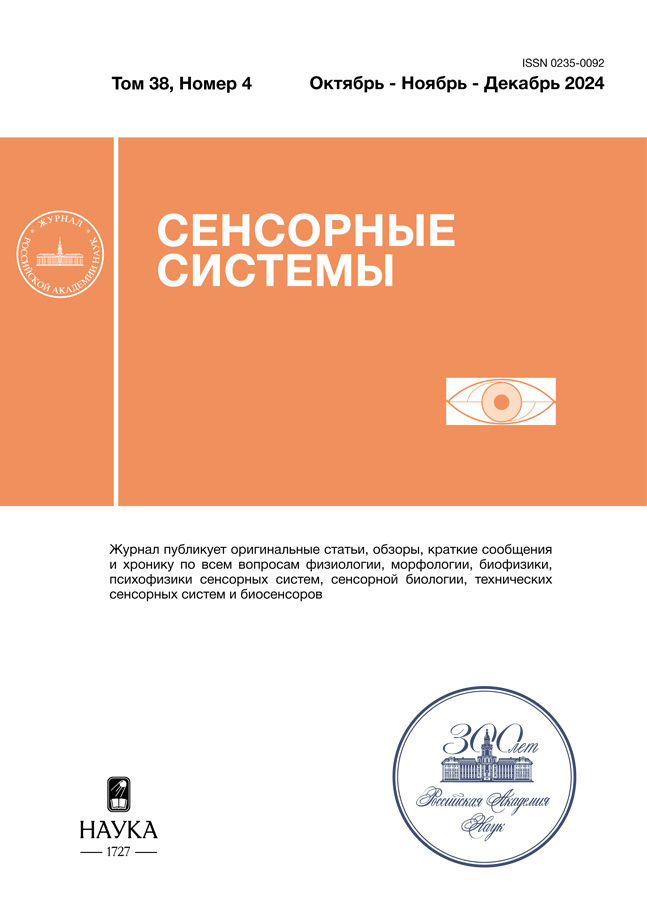Localization of a sound signal in the vertical plane under masking conditions
- 作者: Agaeva M.Y.1
-
隶属关系:
- I.P. Pavlov Institute of Physiology RAS
- 期: 卷 38, 编号 4 (2024)
- 页面: 38-48
- 栏目: СЛУХОВАЯ СИСТЕМА
- URL: https://rjonco.com/0235-0092/article/view/675770
- DOI: https://doi.org/10.31857/S0235009224040048
- EDN: https://elibrary.ru/ADFOZS
- ID: 675770
如何引用文章
详细
The effect of masker on the localization of a sound source in vertical sagittal plane was investigated in simultaneous masking conditions and in the precedence effect paradigm. In the first case, the stationary signal and the masker were presented simultaneously while in the second case the signal onset was delayed relative to the masker onset. The delay was 2, 4, 8, 20, 40, 80 and 200 ms. The signal and the masker were created from two different uncorrelated noise bursts with a bandwidth of 5 to 18 kHz. Duration of noise bursts were 1 s. The masker was placed above the listeners head at an angle of 90 deg and the signal was placed in front of the listener at an angle of 7.5 deg. Perceived positions of signals under masking conditions were compared with those single of the signal or masker presented separately. It is shown that under the masking conditions the probability of detecting a signal decreased. Listeners could localize the signal at the delay of 80 ms and higher. The probability of detecting the signal at 80 ms delay was 92%. The perceived position of signal in masking condition did not significantly differ from the perceived position of single signal. At delays ranging from 0 to 40 ms, listeners mainly showed a perceived masker position that was shifted toward the signal. The shifted position was significantly different from the perceived position of a single masker.
全文:
作者简介
M. Agaeva
I.P. Pavlov Institute of Physiology RAS
编辑信件的主要联系方式.
Email: agamu_1@mail.ru
俄罗斯联邦, 199034, St. Petersburg, Makarova emb., 6
参考
- Agaeva M. Ju., Al'tman Ja. A. Porogi obnaruzhenija jeha dlja serii shumovyh posylok v vertikal'noj sagittal'noj ploskosti [Echo Threshold Value for Series of Noise Bursts in Vertical Plane]. Sensornye sistemy [Sensory systems]. 2009. V. 23(3). P. 181–185. (in Russian).
- Agaeva M. Yu., Petropavlovskaia E. A. Localization of Correlated and Uncorrelated Audio Signals in the Horizontal Plane under Masking Conditions. Human Physiology. 2023. V. 49. № 1. P. 44–54. doi: 10.1134/S0362119722100012
- Baumgartner R., Majdak P. Laback B. Modeling sound-source localization in sagittal planes for human listeners. J Acoust Soc Am. 2014. V. 136. P. 791–802. doi: 10.1121/1.4887447.
- Van Bentum G. C., Van Opstal A. J., Van Aartrijk C. M. M., Van Wanrooij M. M. Level-weighted averaging in elevation to synchronous amplitude-modulated sounds. J Acoust Soc Am. 2017. V. 142. P. 3094–3103. doi: 10.1121/1.5011182
- Best V., van Schaik A., Carlile S. Separation of concurrent broadband sound sources by human listeners. J Acoust Soc Am. 2004. V. 115. P. 324–336. doi: 10.1121/1.1632484
- Blauert J. Spatial hearing: the psychophysics of human sound localization. Harvard, MA: MIT Рress., 1997. 504 p.
- Bregman A. S. Auditory Scene Analysis: The Perceptual Organization of Sound. Cambridge, MA: MIT Press.; 1990. 792 p.
- Bremen P., Van Wanrooij M. M., Van Opstal A. J. Pinna cues determine orienting response modes to synchronous sounds in elevation. J. Neurosci. 2010. V. 30. P. 194–204. doi: 10.1523/JNEUROSCI.2982–09.2010
- Brown A. D., Stecker G. C., Tollin D. J. The precedence effect in sound localisation. J Assoc Res Otolaryngol. 2015. V. 16. P. 1–28. doi: 10.1007/s10162–014–0496–2
- Dizon R. M., Litovsky R. Y. Localisation dominance in the median-sagittal plane: effect of stimulus duration. J. Acoust. Soc. Am. 2004. V. 115. P. 3142–3155. doi: 10.1121/1.1738687
- Ege R., van Opstal A. J., Bremen P., van Wanrooij M. M. Testing the Precedence Effect in the Median Plane Reveals Backward Spatial Masking of Sound. Sci Rep. 2018. V. 8:8670. P. 1–10. doi: 10.1038/s41598–018–26834–2
- Johnson О. S., O’Connor K.N., Sutter M. Segregating two simultaneous sounds in elevation using temporal envelope: Human psychophysics and a physiological model. J. Acoust. Soc. Am. 2015. V. 138. № 1. P 33–43. doi: 10.1121/1.4922224
- Lee A. K., Deane-Pratt A., Shinn-Cunningham B. G. Localization interference between components in an auditory scene. J. Acoust. Soc. Am. 2009. V. 126. P. 2543–2555. doi: 10.1121/1.3238240
- Litovsky R. Y., Colburn H. S., Yost W. A. Guzman S. J. The precedence effect. J. Acoust. Soc. Am. 1999. V. 106. P. 1633–1654. doi: 10.1121/1.427914
- Van Opstal A. J., Vliegen J. Van Esch T. Reconstructing spectral cues for sound localisation from responses to rippled noise stimuli. Plos One. 2017. V. 12. № 3. Р. e0174185. doi: 10.1371/journal.pone.0174185
- Vliegen J., Van Opstal A. J. The influence of duration and level on human sound localisation. J. Acoust. Soc. Am. 2004. V. 115. P. 1705–1713. doi: 10.1121/1.1687423
- Yao D., Li J.; Xia R., Yan Y. The role of spectral cues in vertical plane elevation perception. Acoust. Sci. & Tech.2020. V. 41. № 1. P. 435–438. doi: 10.1250/ast.41.435
- Yost W. A., Pastore M. T., Dorman M. F. Sound source localization is a multisystem process. Acoust Sci Technol. 2020. V. 41. P. 113. doi: 10.1250/ast.41.113
补充文件













